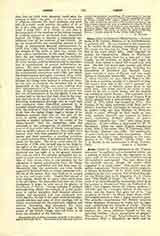

Asses, FEAST OF. —The celebration of the “Festum Asinorum” in medieval and ecclesiastical circles was a pastime in which all, from the dignitaries in the upper stalls of the sanctuary to the humblest among the esclaffardi, participated. The feast dates from the eleventh century, though the source which suggested it is much older. This source was the pseudo-Augustinian “Sermo contra judos, paganos, et Arianos de Symbolo” (P.L., XLII, 1117), written probably in the sixth century, but ascribed throughout the Middle Ages to St. Augustine (E. K. Chambers, “The Medieval Stage”, II, 52). For the reprint of an eleventh-century manuscript which gives the sermon in dramatized form, see Edelestand du Meril, “Les Origines latines du theatre moderne”, 179-187; and for a complete history of this manuscript, and the theatre that grew out of it, “Les prophotes du Christ”, by Marius Sepet (Paris, 1878). The original sermon is itself a highly dramatic piece. The preacher impersonates the Hebrew prophets whose Messianic utterances he works into an argument establishing the Divinity of Christ. Having confuted. the Jews out of the mouths of their own teachers, the orator addresses himself to the unbelieving Gentiles– “Ecce, convertimur ad gentes.” The testimony of Virgil, Nabuchodonosor, and the Erythraean Sibyl is eloquently set forth and interpreted in favor of the general thesis. As early as the eleventh century this sermon had taken the form of a metrical dramatic dialogue, the stage-arrangement adhering closely to the original. Additions and adaptations were gradually introduced. A Rouen manuscript of the thirteenth century outlined in Ducange (Glossarium, s.v. Festum) exhibits twenty-eight prophets as taking part in the play. After Terce, the rubric directs, “let the procession move to the church, in the center of which let there be a furnace… and an idol for the brethren to refuse to worship.” The procession filed into the choir. On the one side were seated Moses, Amos, Isaias, Aaron… Balaam and his Ass…Zachary and Elizabeth, John the Baptist and Simeon. The three Gentile prophets sat opposite. The proceedings were conducted under the auspices of St. Augustine, whom the precentor represented. Beginning with Moses, the presiding dignitary called on each of the prophets, who successively testified to the birth of the Messiah. When the Sibyl had recited her acrostic lines on the Signs of Judgment (Du Moril, 186), all the prophets sang in unison a hymn of praise to the long-sought Savior. Mass immediately followed. In all this the part that pleased the congregation was the role of Balaam and the Ass; hence the popular designation of the “Processus Prophetarum” as “the Feast of the Ass“. The part of Balaam was soon dissociated from its surroundings and expanded into an independent drama. The Rouen rubrics direct that two messengers be sent by King Balaak to bring forth the prophet. Balaam advances riding on a gorgeously caparisoned ass (a wooden, or hobby, ass, for the rubric immediately bids somebody to hide beneath the trappings—not an enviable position when the further direction to the rider was carried out- “and let him goad the ass with his spurs”). From the Chester pageant it is clear that the prophet rode on a wooden animal, since the rubric supposes that the speaker for the beast is “in asina” (Thos. Wright, “The Chester Plays,” I, v). Then follows the scene in which the ass meets the angered angel and protests at length against the cruelty of the rider. Once detached from the parent stem, the “Festum Asinorum” branched in various directions. In the Beauvais thirteenth-century document, quoted by the editors of Ducange, the “Feast of Asses” is already an independent Trope with the date and purpose of its celebration changed. At Beauvais the Ass may have continued his minor role of enlivening the long procession of Prophets. On the fourteenth of January, however, he discharged an important function in that city’s festivities. On the feast of the Flight into Egypt the most beautiful girl in the city, with a pretty child in her arms, was placed on a richly draped ass, and conducted with religious gravity to St. Stephen’s Church. The Ass (possibly a wooden figure) was stationed at the right of the altar, and the Mass was begun. After the Introit a Latin Prose was sung. The first stanza and its French refrain may serve as a specimen of the nine that follow:
Orientis partibus
Adventavit Asinus
Pulcher et fortissimus
Sarcinis aptissimus.
Hez, Sire Asnes, car chantez,
Belle bouche rechignez,
Vous aures du foin assez
Et de l’avoine a plantez.
– “From the Eastern lands the Ass is come, beautiful and very brave, well fitted to bear burdens. Up! Sir Ass, and sing. Open your pretty mouth. Hay will be yours in plenty, and oats in abundance.”
Mass was continued, and at its end, apparently without awakening the least consciousness of its impropriety, the following direction was observed: “In fine Missae sacerdos, versus ad populum, vice `Ite, Missa Est’, ter hinhannabit: populus vero, vice ‘Dee Gratias’, ter respondebit, `Hinham, hinham, hinham.’ “- “At the end of Mass, the priest, having turned to the people, in lieu of saying the `Ite, Missa est’, will bray thrice; the people instead of replying ‘Deo) Gratias’ say, `Hinham, hinham, hinham.'”—This is the sole instance of a service of this nature in connection with the Feast of the Ass. The Festum Asinorum gradually lost its identity, and became incorporated in the ceremonies of the Deposuit or united in the general merry-making on the Feast of Fools. The “Processus Prophetarum”, whence it drew its origin, survives in the Corpus Christi and Whitsun Cycles, that stand at the head of the modern English drama.
T. J. CROWLEY

